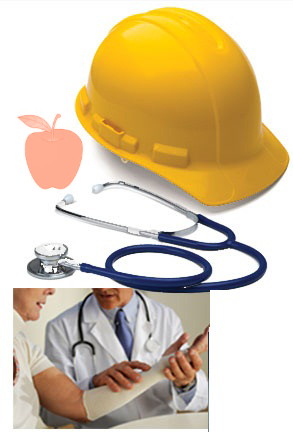
Work-Related Diseases and Occupational Diseases:
Diseases caused by exposure to or contact with hazards in work are generally called 'occupational / work-related diseases'. It is the duty of the employers to prevent employees from contacting occupational / work-related diseases.
An occupational disease is a health problem caused by exposure to a workplace health hazard.
An occupational disease is any chronic ailment that occurs as a result of work or occupational activity. It is an aspect of occupational safety and health. An occupational disease is typically identified when it is shown that it is more prevalent in a given body of workers than in the general population, or in other worker populations. The first such disease to be recognised, squamous-cell carcinoma of the scrotum was identified in chimney sweep boys by Sir Percival Pott in 1775. Occupational hazards that are of a traumatic nature (such as falls by roofers) are not considered to be occupational diseases.
Under the law of workers' compensation in many jurisdictions, there is a presumption that specific disease are caused by the worker being in the work environment and the burden is on the employer or insurer to show that the disease came about from another cause. Diseases compensated by national workers compensation authorities are often termed occupational diseases. However many countries do not offer compensations for certain diseases like musculoskeletal disorders caused by work (e.g. in Norway).Therefore the term work-related diseases is utilized to describe diseases of occupational origin. This term however would then include both compensable and non-compensable diseases that have occupational origins.
Some well-known occupational diseases include:
Lung diseases:
Occupational lung diseases include asbestosis among asbestos miners and those who work with friable asbestos insulation, as well as black lung (coalworker's, pneumoconiosis) among coal miners,silicosis among miners and quarrying and tunnel operators and byssinosis among workers in parts of the cotton textile industry.
Skin diseases:
Occupational skin diseases and conditions are generally caused by chemicals and having wet hands for long periods while at work. Eczema is by far the most common, but urticaria, sunburn and skin cancer are also of concern.
High-risk occupations include:
Hairdressing, Catering ,Healthcare, Printing ,Metal machining ,Motor vehicle repair ,Construction
source link:
http://en.wikipedia.org/wiki/
-----------------------------------------------------------------
criteria deciding To determine occupational diseases include :
there is a causal relationship with a specific agent, exposure or work process; they occur in connection with a specific work environment and/or in specific occupations; they occur among the groups of workers concerned with a frequency which exceeds the average incidence within the rest of the population; and there is scientific evidence of a clearly defined pattern of disease following exposure and plausibility of cause.
Prevention occupational diseases:
- Education has a key role in promoting the prevention of occupational diseases.
- Find out what materials and substances are being used in your workplace.
- Find out how to work safely around materials and equipment in your workplace. Your supervisor is required to provide you with this information and appropriate training. You can also contact your joint health and safety committee or representative.
- Use protective equipment provided by your employer. Make sure that you know how to use it properly. If you don’t know, ask.
- Be alert to symptoms or changes in your health.
- Tell your doctor where you work, what you do, and what substances you work with.
Keep records
- Keep a list of all the jobs and industries that you have worked in. It will help if you need to file an occupational disease.